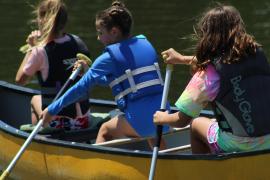Open or closed in summer 2020, camps are looking to 2021 and evaluating options for operations next summer. Just as the virus was “novel,” camps that operated during the 2020 season often reported a “camp reimagined” experience, with dates shifted, occupancy limited, public health measures in place, and programs altered to meet the new reality of the pandemic. How will camps need to plan, prepare, and operate for the 2021 season? While much uncertainty continues, a COVID-19-free landscape is unlikely. Provided here are updates on the progress of the pandemic and expert insights into the hot topics of the time to assist camp professionals in planning and implementing safe and engaging camp experiences during the upcoming year.
Looking Back at Summer 2020 and Ahead to Summer 2021
The trends of COVID-19 in 2020 are coming into focus. Many camp-aged children sheltered at home during the spring of 2020 as reflected in the low pediatric COVID-19 rates throughout the season. Summer brought a steady increase in rates presumably as states opened back up and children began to socially interact with one another. Infection rates are increasing with the return to school and are likely to further increase throughout the 2020–21 school and college year. In addition, winter conditions and increased indoor activities are apt to further contribute to this trend. For these reasons, camps planning to operate in-person programs in 2021 may experience more campers and staff with COVID-19 than in 2020.
As of October 2020, we believe camps should continue consistent implementation of both cohort strategies and nonpharmaceutical interventions (NPIs) to limit the introduction of infected persons and the spread of COVID-19 within camp. Diligently and consistently adhering to the recommendations outlined in the recently updated Field Guide, alongside local public health requirements, will provide a robust foundation for preventing and mitigating COVID-19 at camp in summer 2021. Testing, if accessible and affordable, might be an additional tool available to camp in 2021. While expensive and difficult to access in many places, we believe testing for presymptomatic and asymptomatic conditions will become more accessible in the coming months.
Our strongest tool continues to be the layering of NPIs. Camp data from 2020 suggests that camps that successfully prevented and mitigated COVID-19 among campers and staff used multiple strategies (masks, cohorts, distancing, frequent handwashing, and enhanced sanitation, for example). Additional insights are expected in the coming weeks with the analysis of the data from ACA's CampCounts 2020 survey conducted this month. While camps may consider successfully operating in 2021 with these layered protections, we believe we will continue to strongly advise against certain camp program elements. Crowded, indoor activities, such as theater performances, and all high-contact camp games will likely again be unadvisable in 2021. Yelling, singing, and other vigorous activities can increase the spread of respiratory droplets and should only be done when multiple NPIs are in use. Similarly, camps should consider eliminating or limiting visitors and parent/caregiver programs during the camp season.
Camp and Vaccines
Several promising COVID-19 vaccines are on the horizon. If Phase 3 trials demonstrate safe and reliable data, experts believe that vaccine availability and distribution may occur by early to mid-summer 2021. Widespread vaccination of camp-age children, however, is unlikely prior to the summer season for at least two reasons. First, essential workers and those at highest risk will be prioritized to receive the vaccine while healthy children and adults will be eligible in later phases of vaccine delivery. Second, safety data for COVID-19 vaccination of children will be gathered later, as only one vaccine manufacturer to date has opened recruitment in Phase 3 trials to children age 12 and older. Although we believe that camp staff may meet state criteria as essential childcare workers eligible for vaccination, camps are encouraged to plan for a camp 2021 season without the benefits of vaccination.
Applying Know-How, Experience, and Tools from 2020 to Camp 2021
We have the benefit of ample evidence from 2020 to help camps prepare for 2021
- Guidance on camp planning and operations during COVID-19 is available now from the US CDC, state departments of health, and camp industry sources such as ACA and Association for Camp Nursing (ACN). Case studies from camps that operated in summer 2020 provide insight into what worked and opportunities for improvement. One theme in these case studies is that a healthy camp begins before camp and that ensuring healthy pre-camp behaviors translates to a healthy camp operation.
- Published data on the effectiveness of NPIs is available on several camp experiences, including:
- A study of four overnight camps in Maine that demonstrated that diligently employing a multilayered approach can prevent and mitigate the spread of COVID-19 in overnight settings
- A study of more than 22 overnight camps in Barcelona, Spain, that demonstrated the effectiveness of using a similar approach to that used in Maine
- The case of an outbreak in a Georgia overnight camp where relaxing the NPI strategy resulted in hundreds of infected participants and the closure of the camp
- The ACA and ACN have surveyed and interviewed hundreds of day and overnight camps that operated in-person programs and will be sharing this collective experience in the upcoming weeks.
- The collaboration between EH&E, ACN, and ACA continues through expansion and updated Field Guide for Camps, including new chapters such as Technology and Controls and Medical Testing for Screening and Diagnosis, which have been designed to provide helpful information that was not available prior to the start of the 2020 camp season.
ACA looks forward to continuing to support camps as they navigate the pathway of implementing safe and engaging camp experiences during the time of COVID-19. We are learning from this past season, the scientific community, and from public health and medical experts from around the world. With this collective knowledge, and hopefully new tools, such as affordable testing, we are confident that camps will have all the tools they need to operate programs that are designed to keep their campers and staff safe and healthy in 2021.
Contributing authors:
Laura Blaisdell, MD/MPH, FAAP, Maine Medical Center
Laurie Browne, PhD, American Camp Association
Matt Fragala, MS, CIH, CSP, EH&E
Tracey Gaslin, PhD, CPNP, FNP-BC, CRNI, RN-BC, Association of Camp Nursing
David Shore, EH&E
Photo courtesy of Liberty Lake Day Camp in Mansfield Township, New Jersey



